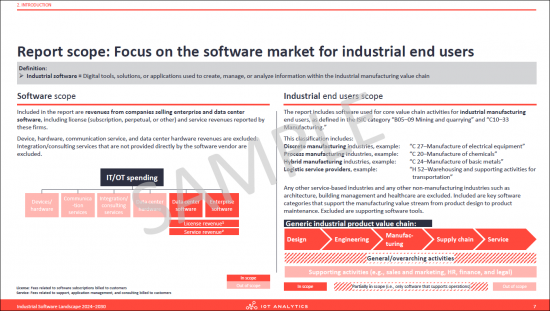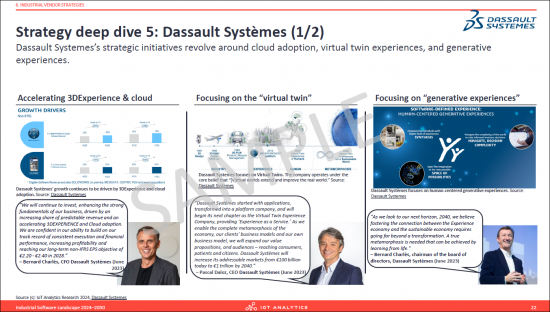|
市场调查报告书
商品编码
1583177
工业软体前景:2024-2030Industrial Software Landscape 2024-2030 |
|||||||
该报告是 IoT Analytics 正在进行的产业转型终端市场研究的一部分。它包括工业软体定义、市场预测、供应商市场占有率、总体趋势、供应商策略以及与各个软体类别相关的特定趋势。
资讯图表



该报告包括 180 多家工业软体公司的资料库* ,分为 5 个软体组和 14 个软体类别。
*包含在团队使用者许可证及以上版本中。
设计/工程
- CAS
- EDA
- PLM
资讯图表


製造
- 机器控制
- MOM
- EAM
供应链
- 供应链规划/设计
- 供应链执行
服务
- 现场服务
一般/综合
- 云端基础设施和服务
- 网路安全
- 虚拟化
- 远端存取
- 数据与分析
资讯图表

刊登公司
|
|
目录
第1章 内容提要
第2章 简介
第3章 分类
- 1、工业软体的分类
第 4 章 市场规模/预测
- 1.市场概况:工业软体
- 2.市场概况:工业软体:依软体组划分
- 3.工业软体市场预测:依软体类别
第5章 产业供应商策略
- 1.详细策略分析1:Siemens
- 2.详细策略分析2:SAP
- 3.详细策略分析3:Schneider Electric
- 4.详细策略分析4:PTC
- 5.详细策略分析5:Dassault Systemes
- 6.详细策略分析6:Autodesk
第6章 市场整体趋势
- 1.市场趋势概述
- 2.趋势1
- 3.趋势2
- 4.趋势3
- 5.趋势4
- 6.趋势5
- 7.趋势6
- 8.趋势7
第7章 详细分析:依软体类别
- 1.CAD
- 2.EDA
- 3.PLM
- 4.机器控制软体
- 5.MOM
- 6.供应链:规划与设计
- 7.供应链:执行
- 8.现场服务
- 9.EAM
- 10.云端基础设施和服务
- 11.网路安全
- 12.虚拟化
- 13.远端访问
- 14.数据与分析
第8章研究方法
第 9 章. 关于 IoT 分析
The "Industrial Software Landscape 2024-2030" is part of IoT Analytics' ongoing coverage of industrial transformation end market. The information in this report is derived from reported vendor revenues, survey data, and qualitative research, i.e., interviews and briefings with software vendors. The document includes a definition of industrial software, market projections, vendor market shares, general trends, vendor strategies, and specific trends related to individual software categories. The main purpose of this document is to help our readers understand the current industrial software landscape by defining, sizing, and analyzing the market.
INFOGRAPHICS



The report is accompanied by a structured database* with a classification of 180+ industrial software companies in 5 software groups and 14 different software categories:
Design and engineering
- CAS
- EDA
- PLM
INFOGRAPHICS


Manufacturing
- Machine Control
- MOM
- EAM
Supply chain
- Supply chain planning & design
- Suply chain execution
Service
- Field service
General/Overarching
- Cloud infrastructure & services
- Cybersecurity
- Virtualization
- Remote access
- Data & analytics
INFOGRAPHICS

Definition of industrial software
Industrial software = Digital tools, solutions, or applications used to create, manage, or analyze information within the industrial manufacturing value chain.
Industrial software market
The growth for industrial sofware is outperforming the growth for OT hardware. IoT Analytics forecasts the industrial software market to continue growing stongly, driven by cloud and analytics software.
* included with a team user license or higher.
Questions answered:
- What are the market dynamics for the following industrial software markets: CAD, EDA, PLM, MOM, EAM, machine control, cybersecurity, data & analytics, SCM, field service, cloud, virtualization, and remote access?
- What is the market size for industrial software and individual software categories (e.g., CAD, PLM, or MOM)?
- What are the market growth projections for industrial software as well as individual software categories until 2030?
- Which software vendors are leading their markets, and what are their market shares?
- How have market shares developed between 2021 and 2023?
- What strategies do key industrial software companies for the coming years?
- What are the key trends affecting the industrial software market in general?
- What are some individual trends for specific software categories?
Companies mentioned:
A selection of companies mentioned in the report.
|
|
Table of Contents
1. Executive Summary
- 1. Executive summary
- 2. This report highlights smart factory adoption through 6 lenses and 4 deep dives
- 3. 500 people participated in this research that represent a variety of different manufacturers
- 4. The Smart Factory Adoption Report 2024 is part of IoT Analytics' ongoing coverage of Industry 4.0 and IIoT
2. Introduction
- 1. Market definition and scope
- 2. Report motivation
3. Taxonomy
- 1. Industrial software taxonomy
4. Market size and forecast
- 1. Market overview: Industrial software
- 2. Market overview: Industrial software by software group
- 3. Industrial software market forecasts by software category
5. Industrial vendor strategies
- 1. Strategy deep dive 1: Siemens
- 2. Strategy deep dive 2: SAP
- 3. Strategy deep dive 3: Schneider Electric
- 4. Strategy deep dive 4: PTC
- 5. Strategy deep dive 5: Dassault Systemes
- 6. Strategy deep dive 6: Autodesk
6. Overarching market trends
- 1. Market trends overview
- 2. Trend 1
- 3. Trend 2
- 4. Trend 3
- 5. Trend 4
- 6. Trend 5
- 7. Trend 6
- 8. Trend 7
7. Deep dives per software category
- 1. CAD
- 2. EDA
- 3. PLM
- 4. Machine control software
- 5. MOM
- 6. Supply Chain - Planning & design
- 7. Supply Chain - Execution
- 8. Field service
- 9. EAM
- 10. Cloud infrastructure and services
- 11. Cybersecurity
- 12. Virtualization
- 13. Remote access
- 14. Data and analytics









